Security of Payments Act 1999: Analysis, Amendments & Court Actions
VerifiedAdded on 2023/06/03
|9
|2493
|485
Report
AI Summary
This report provides an analysis of the Building and Construction Industry Security of Payments Act 1999 (NSW), examining its purpose, functionality, and impact on the construction industry. It delves into how the act addresses challenges faced by contractors, sub-contractors, and suppliers in receiving payments, ensuring timely compensation for services rendered. The report evaluates the act's influence on regular court actions related to construction disputes, highlighting recent amendments concerning sub-contractor rights and protections. It concludes by emphasizing the act's role in safeguarding the financial interests of parties involved in construction contracts and promoting fair trading practices within the industry.

qwertyuiopasdfghjklzxcvbnmqw
ertyuiopasdfghjklzxcvbnmqwert
yuiopasdfghjklzxcvbnmqwertyui
opasdfghjklzxcvbnmqwertyuiop
asdfghjklzxcvbnmqwertyuiopasd
fghjklzxcvbnmqwertyuiopasdfgh
jklzxcvbnmqwertyuiopasdfghjkl
zxcvbnmqwertyuiopasdfghjklzxc
vbnmqwertyuiopasdfghjklzxcvb
nmqwertyuiopasdfghjklzxcvbnm
qwertyuiopasdfghjklzxcvbnmqw
ertyuiopasdfghjklzxcvbnmqwert
yuiopasdfghjklzxcvbnmqwertyui
Building Law
ertyuiopasdfghjklzxcvbnmqwert
yuiopasdfghjklzxcvbnmqwertyui
opasdfghjklzxcvbnmqwertyuiop
asdfghjklzxcvbnmqwertyuiopasd
fghjklzxcvbnmqwertyuiopasdfgh
jklzxcvbnmqwertyuiopasdfghjkl
zxcvbnmqwertyuiopasdfghjklzxc
vbnmqwertyuiopasdfghjklzxcvb
nmqwertyuiopasdfghjklzxcvbnm
qwertyuiopasdfghjklzxcvbnmqw
ertyuiopasdfghjklzxcvbnmqwert
yuiopasdfghjklzxcvbnmqwertyui
Building Law
Paraphrase This Document
Need a fresh take? Get an instant paraphrase of this document with our AI Paraphraser
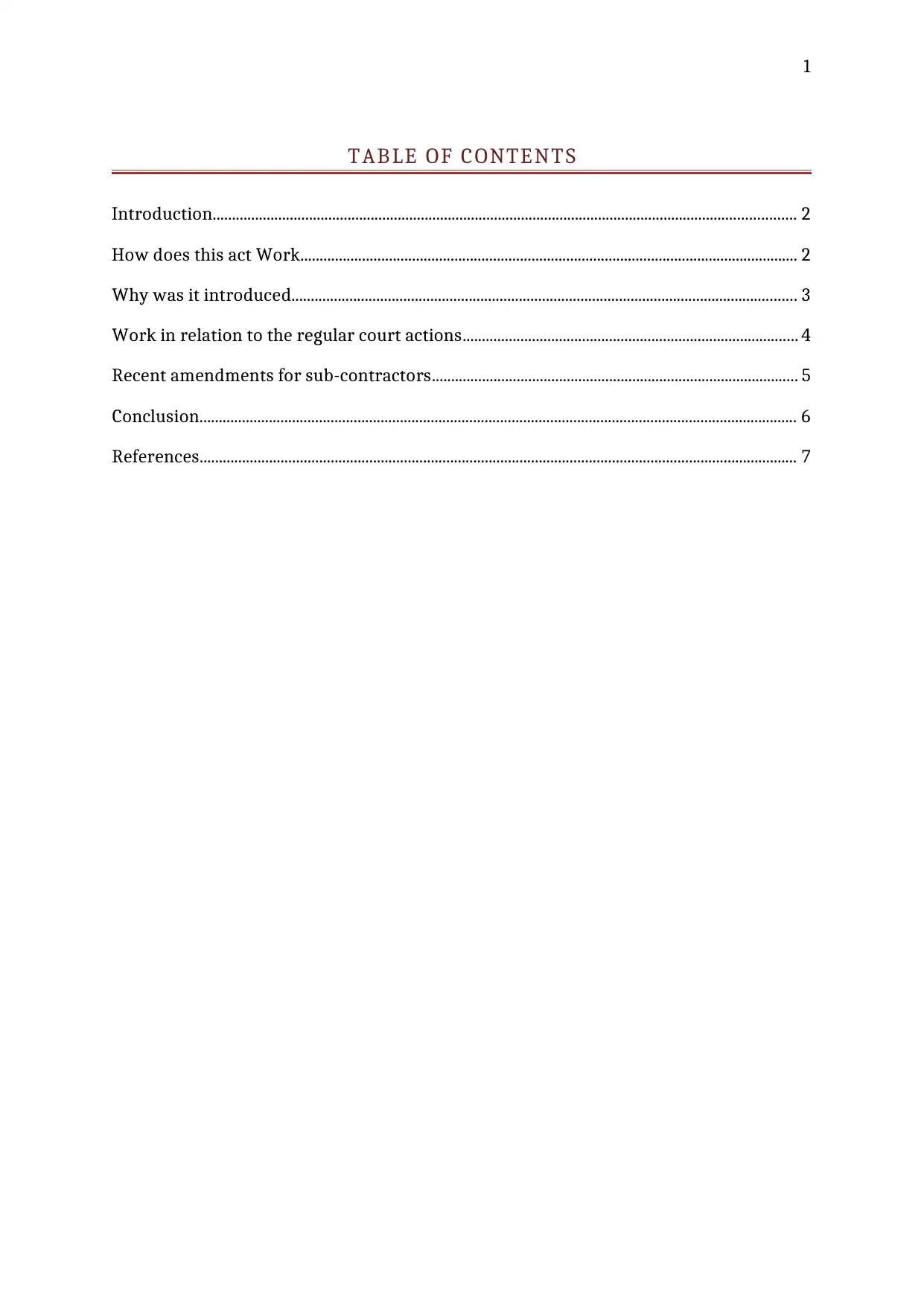
1
TABLE OF CONTENTS
Introduction....................................................................................................................................................... 2
How does this act Work................................................................................................................................. 2
Why was it introduced................................................................................................................................... 3
Work in relation to the regular court actions....................................................................................... 4
Recent amendments for sub-contractors............................................................................................... 5
Conclusion........................................................................................................................................................... 6
References........................................................................................................................................................... 7
TABLE OF CONTENTS
Introduction....................................................................................................................................................... 2
How does this act Work................................................................................................................................. 2
Why was it introduced................................................................................................................................... 3
Work in relation to the regular court actions....................................................................................... 4
Recent amendments for sub-contractors............................................................................................... 5
Conclusion........................................................................................................................................................... 6
References........................................................................................................................................................... 7
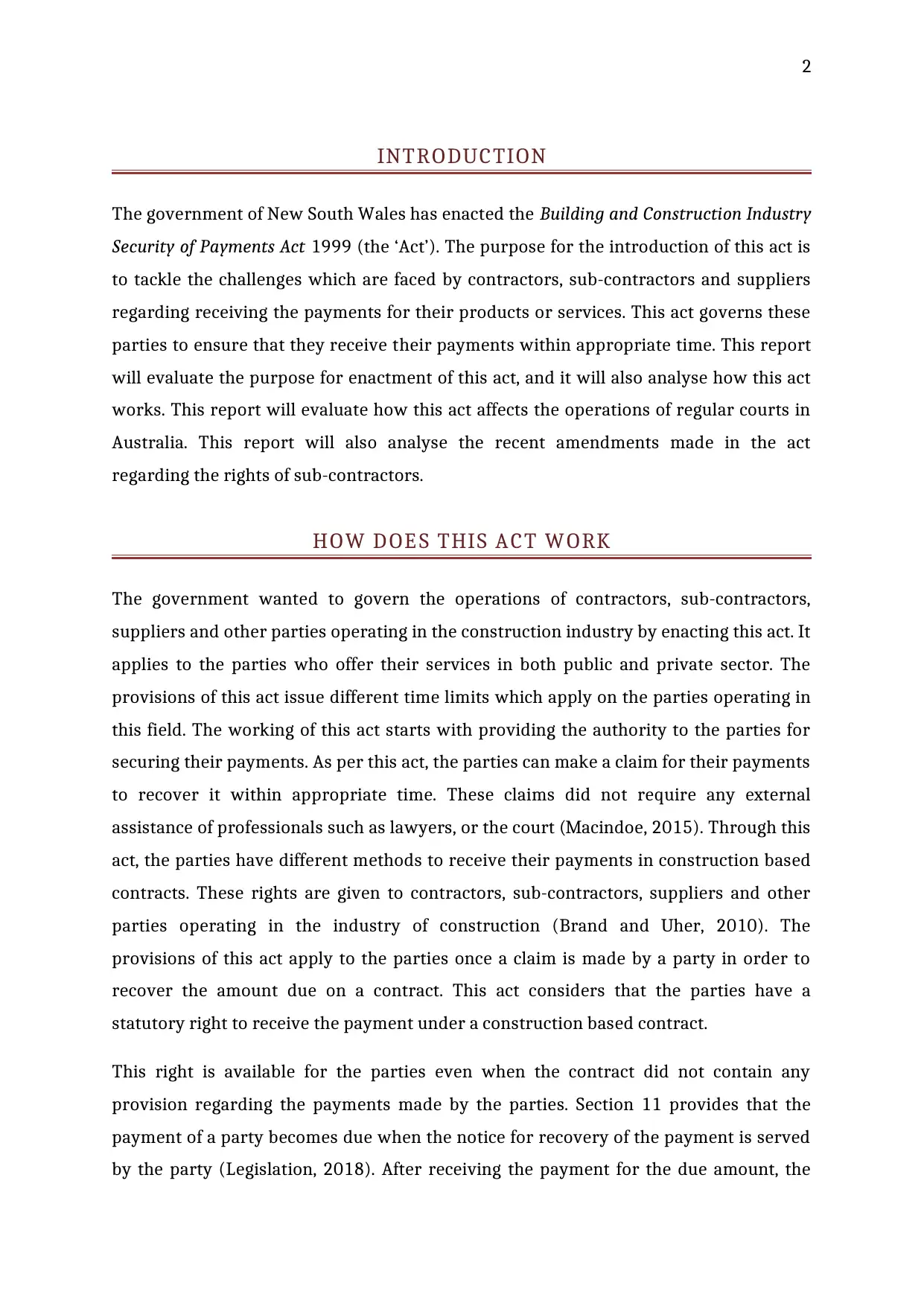
2
INTRODUCTION
The government of New South Wales has enacted the Building and Construction Industry
Security of Payments Act 1999 (the ‘Act’). The purpose for the introduction of this act is
to tackle the challenges which are faced by contractors, sub-contractors and suppliers
regarding receiving the payments for their products or services. This act governs these
parties to ensure that they receive their payments within appropriate time. This report
will evaluate the purpose for enactment of this act, and it will also analyse how this act
works. This report will evaluate how this act affects the operations of regular courts in
Australia. This report will also analyse the recent amendments made in the act
regarding the rights of sub-contractors.
HOW DOES THIS ACT WORK
The government wanted to govern the operations of contractors, sub-contractors,
suppliers and other parties operating in the construction industry by enacting this act. It
applies to the parties who offer their services in both public and private sector. The
provisions of this act issue different time limits which apply on the parties operating in
this field. The working of this act starts with providing the authority to the parties for
securing their payments. As per this act, the parties can make a claim for their payments
to recover it within appropriate time. These claims did not require any external
assistance of professionals such as lawyers, or the court (Macindoe, 2015). Through this
act, the parties have different methods to receive their payments in construction based
contracts. These rights are given to contractors, sub-contractors, suppliers and other
parties operating in the industry of construction (Brand and Uher, 2010). The
provisions of this act apply to the parties once a claim is made by a party in order to
recover the amount due on a contract. This act considers that the parties have a
statutory right to receive the payment under a construction based contract.
This right is available for the parties even when the contract did not contain any
provision regarding the payments made by the parties. Section 11 provides that the
payment of a party becomes due when the notice for recovery of the payment is served
by the party (Legislation, 2018). After receiving the payment for the due amount, the
INTRODUCTION
The government of New South Wales has enacted the Building and Construction Industry
Security of Payments Act 1999 (the ‘Act’). The purpose for the introduction of this act is
to tackle the challenges which are faced by contractors, sub-contractors and suppliers
regarding receiving the payments for their products or services. This act governs these
parties to ensure that they receive their payments within appropriate time. This report
will evaluate the purpose for enactment of this act, and it will also analyse how this act
works. This report will evaluate how this act affects the operations of regular courts in
Australia. This report will also analyse the recent amendments made in the act
regarding the rights of sub-contractors.
HOW DOES THIS ACT WORK
The government wanted to govern the operations of contractors, sub-contractors,
suppliers and other parties operating in the construction industry by enacting this act. It
applies to the parties who offer their services in both public and private sector. The
provisions of this act issue different time limits which apply on the parties operating in
this field. The working of this act starts with providing the authority to the parties for
securing their payments. As per this act, the parties can make a claim for their payments
to recover it within appropriate time. These claims did not require any external
assistance of professionals such as lawyers, or the court (Macindoe, 2015). Through this
act, the parties have different methods to receive their payments in construction based
contracts. These rights are given to contractors, sub-contractors, suppliers and other
parties operating in the industry of construction (Brand and Uher, 2010). The
provisions of this act apply to the parties once a claim is made by a party in order to
recover the amount due on a contract. This act considers that the parties have a
statutory right to receive the payment under a construction based contract.
This right is available for the parties even when the contract did not contain any
provision regarding the payments made by the parties. Section 11 provides that the
payment of a party becomes due when the notice for recovery of the payment is served
by the party (Legislation, 2018). After receiving the payment for the due amount, the
⊘ This is a preview!⊘
Do you want full access?
Subscribe today to unlock all pages.

Trusted by 1+ million students worldwide
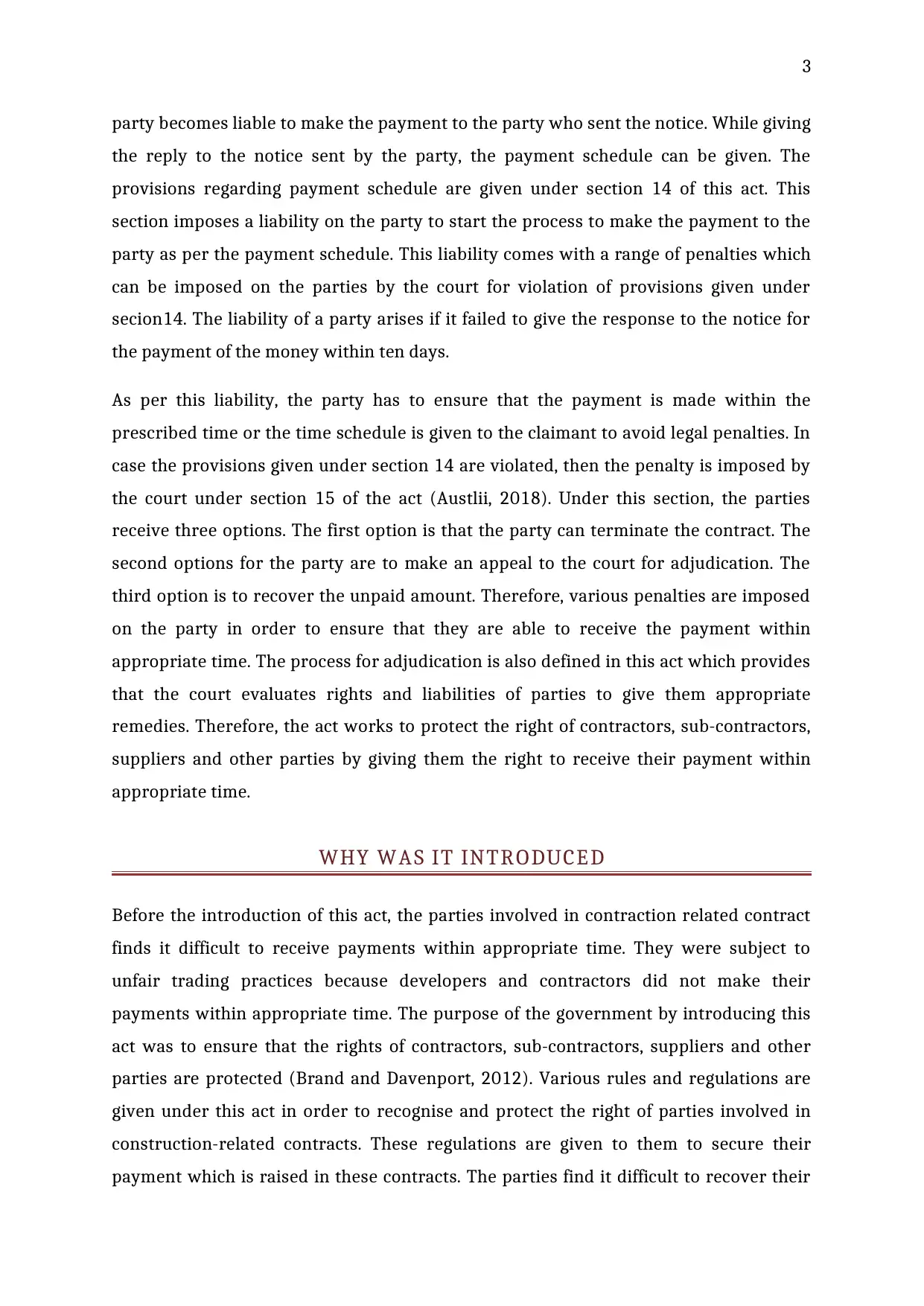
3
party becomes liable to make the payment to the party who sent the notice. While giving
the reply to the notice sent by the party, the payment schedule can be given. The
provisions regarding payment schedule are given under section 14 of this act. This
section imposes a liability on the party to start the process to make the payment to the
party as per the payment schedule. This liability comes with a range of penalties which
can be imposed on the parties by the court for violation of provisions given under
secion14. The liability of a party arises if it failed to give the response to the notice for
the payment of the money within ten days.
As per this liability, the party has to ensure that the payment is made within the
prescribed time or the time schedule is given to the claimant to avoid legal penalties. In
case the provisions given under section 14 are violated, then the penalty is imposed by
the court under section 15 of the act (Austlii, 2018). Under this section, the parties
receive three options. The first option is that the party can terminate the contract. The
second options for the party are to make an appeal to the court for adjudication. The
third option is to recover the unpaid amount. Therefore, various penalties are imposed
on the party in order to ensure that they are able to receive the payment within
appropriate time. The process for adjudication is also defined in this act which provides
that the court evaluates rights and liabilities of parties to give them appropriate
remedies. Therefore, the act works to protect the right of contractors, sub-contractors,
suppliers and other parties by giving them the right to receive their payment within
appropriate time.
WHY WAS IT INTRODUCED
Before the introduction of this act, the parties involved in contraction related contract
finds it difficult to receive payments within appropriate time. They were subject to
unfair trading practices because developers and contractors did not make their
payments within appropriate time. The purpose of the government by introducing this
act was to ensure that the rights of contractors, sub-contractors, suppliers and other
parties are protected (Brand and Davenport, 2012). Various rules and regulations are
given under this act in order to recognise and protect the right of parties involved in
construction-related contracts. These regulations are given to them to secure their
payment which is raised in these contracts. The parties find it difficult to recover their
party becomes liable to make the payment to the party who sent the notice. While giving
the reply to the notice sent by the party, the payment schedule can be given. The
provisions regarding payment schedule are given under section 14 of this act. This
section imposes a liability on the party to start the process to make the payment to the
party as per the payment schedule. This liability comes with a range of penalties which
can be imposed on the parties by the court for violation of provisions given under
secion14. The liability of a party arises if it failed to give the response to the notice for
the payment of the money within ten days.
As per this liability, the party has to ensure that the payment is made within the
prescribed time or the time schedule is given to the claimant to avoid legal penalties. In
case the provisions given under section 14 are violated, then the penalty is imposed by
the court under section 15 of the act (Austlii, 2018). Under this section, the parties
receive three options. The first option is that the party can terminate the contract. The
second options for the party are to make an appeal to the court for adjudication. The
third option is to recover the unpaid amount. Therefore, various penalties are imposed
on the party in order to ensure that they are able to receive the payment within
appropriate time. The process for adjudication is also defined in this act which provides
that the court evaluates rights and liabilities of parties to give them appropriate
remedies. Therefore, the act works to protect the right of contractors, sub-contractors,
suppliers and other parties by giving them the right to receive their payment within
appropriate time.
WHY WAS IT INTRODUCED
Before the introduction of this act, the parties involved in contraction related contract
finds it difficult to receive payments within appropriate time. They were subject to
unfair trading practices because developers and contractors did not make their
payments within appropriate time. The purpose of the government by introducing this
act was to ensure that the rights of contractors, sub-contractors, suppliers and other
parties are protected (Brand and Davenport, 2012). Various rules and regulations are
given under this act in order to recognise and protect the right of parties involved in
construction-related contracts. These regulations are given to them to secure their
payment which is raised in these contracts. The parties find it difficult to recover their
Paraphrase This Document
Need a fresh take? Get an instant paraphrase of this document with our AI Paraphraser
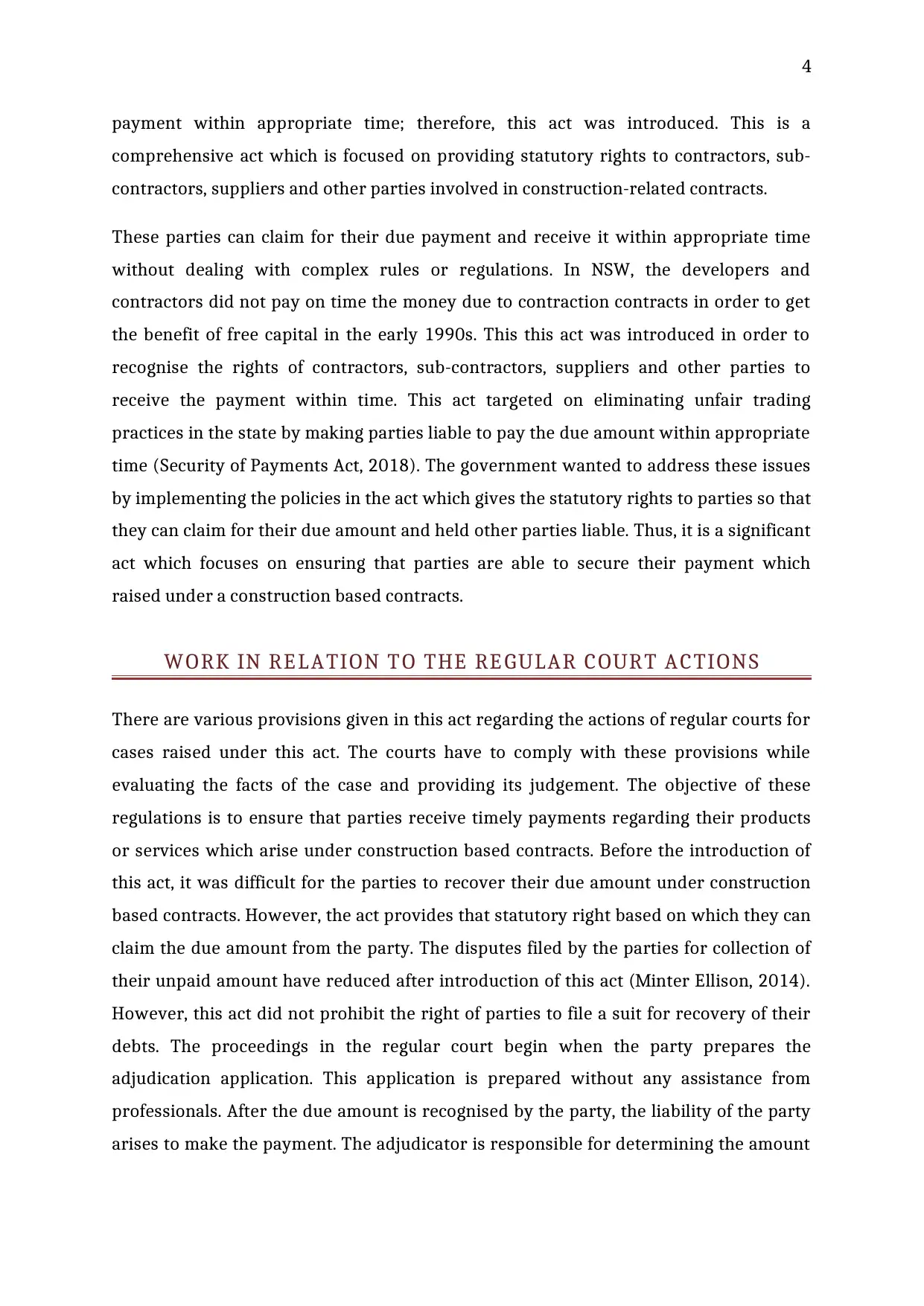
4
payment within appropriate time; therefore, this act was introduced. This is a
comprehensive act which is focused on providing statutory rights to contractors, sub-
contractors, suppliers and other parties involved in construction-related contracts.
These parties can claim for their due payment and receive it within appropriate time
without dealing with complex rules or regulations. In NSW, the developers and
contractors did not pay on time the money due to contraction contracts in order to get
the benefit of free capital in the early 1990s. This this act was introduced in order to
recognise the rights of contractors, sub-contractors, suppliers and other parties to
receive the payment within time. This act targeted on eliminating unfair trading
practices in the state by making parties liable to pay the due amount within appropriate
time (Security of Payments Act, 2018). The government wanted to address these issues
by implementing the policies in the act which gives the statutory rights to parties so that
they can claim for their due amount and held other parties liable. Thus, it is a significant
act which focuses on ensuring that parties are able to secure their payment which
raised under a construction based contracts.
WORK IN RELATION TO THE REGULAR COURT ACTIONS
There are various provisions given in this act regarding the actions of regular courts for
cases raised under this act. The courts have to comply with these provisions while
evaluating the facts of the case and providing its judgement. The objective of these
regulations is to ensure that parties receive timely payments regarding their products
or services which arise under construction based contracts. Before the introduction of
this act, it was difficult for the parties to recover their due amount under construction
based contracts. However, the act provides that statutory right based on which they can
claim the due amount from the party. The disputes filed by the parties for collection of
their unpaid amount have reduced after introduction of this act (Minter Ellison, 2014).
However, this act did not prohibit the right of parties to file a suit for recovery of their
debts. The proceedings in the regular court begin when the party prepares the
adjudication application. This application is prepared without any assistance from
professionals. After the due amount is recognised by the party, the liability of the party
arises to make the payment. The adjudicator is responsible for determining the amount
payment within appropriate time; therefore, this act was introduced. This is a
comprehensive act which is focused on providing statutory rights to contractors, sub-
contractors, suppliers and other parties involved in construction-related contracts.
These parties can claim for their due payment and receive it within appropriate time
without dealing with complex rules or regulations. In NSW, the developers and
contractors did not pay on time the money due to contraction contracts in order to get
the benefit of free capital in the early 1990s. This this act was introduced in order to
recognise the rights of contractors, sub-contractors, suppliers and other parties to
receive the payment within time. This act targeted on eliminating unfair trading
practices in the state by making parties liable to pay the due amount within appropriate
time (Security of Payments Act, 2018). The government wanted to address these issues
by implementing the policies in the act which gives the statutory rights to parties so that
they can claim for their due amount and held other parties liable. Thus, it is a significant
act which focuses on ensuring that parties are able to secure their payment which
raised under a construction based contracts.
WORK IN RELATION TO THE REGULAR COURT ACTIONS
There are various provisions given in this act regarding the actions of regular courts for
cases raised under this act. The courts have to comply with these provisions while
evaluating the facts of the case and providing its judgement. The objective of these
regulations is to ensure that parties receive timely payments regarding their products
or services which arise under construction based contracts. Before the introduction of
this act, it was difficult for the parties to recover their due amount under construction
based contracts. However, the act provides that statutory right based on which they can
claim the due amount from the party. The disputes filed by the parties for collection of
their unpaid amount have reduced after introduction of this act (Minter Ellison, 2014).
However, this act did not prohibit the right of parties to file a suit for recovery of their
debts. The proceedings in the regular court begin when the party prepares the
adjudication application. This application is prepared without any assistance from
professionals. After the due amount is recognised by the party, the liability of the party
arises to make the payment. The adjudicator is responsible for determining the amount
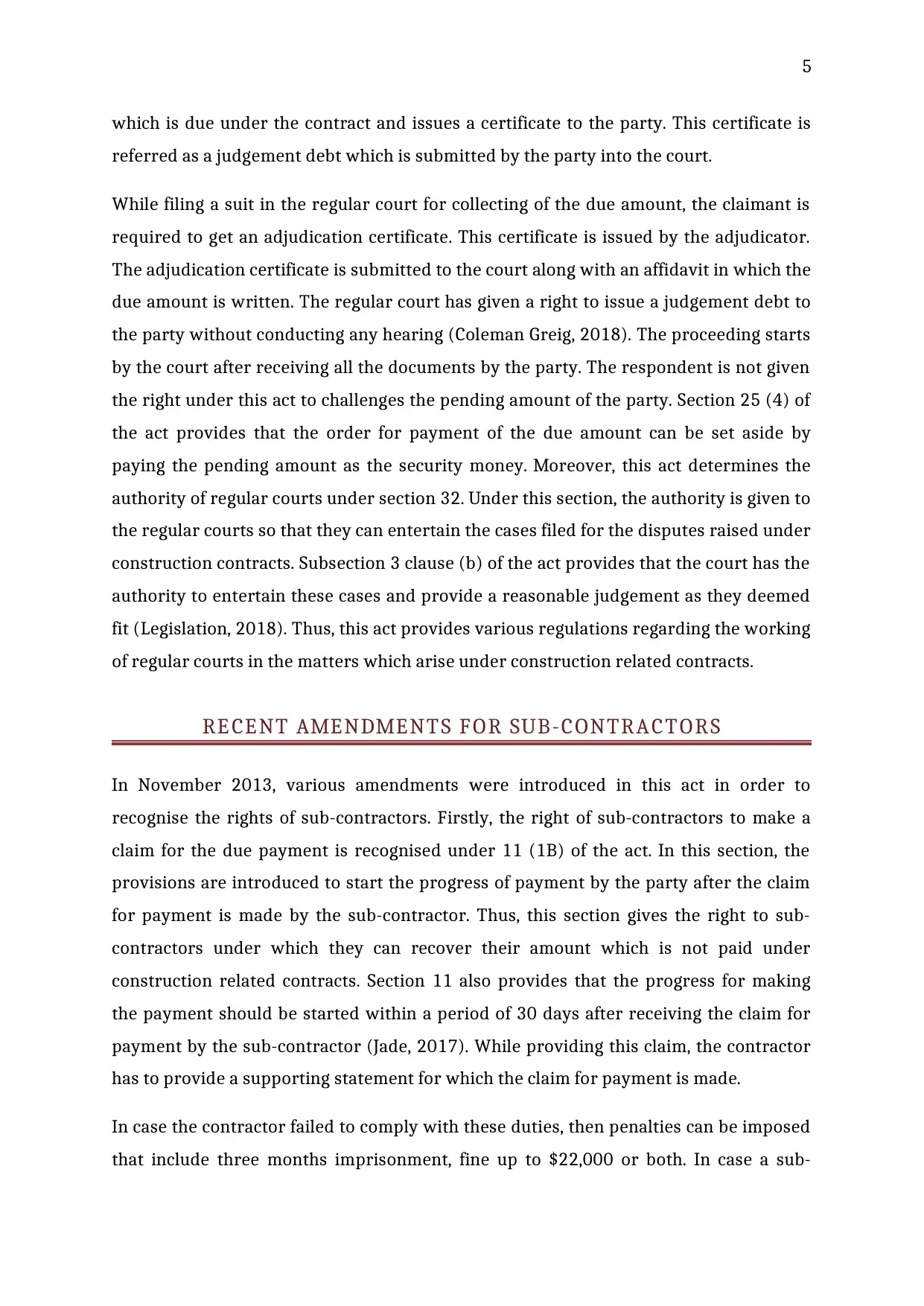
5
which is due under the contract and issues a certificate to the party. This certificate is
referred as a judgement debt which is submitted by the party into the court.
While filing a suit in the regular court for collecting of the due amount, the claimant is
required to get an adjudication certificate. This certificate is issued by the adjudicator.
The adjudication certificate is submitted to the court along with an affidavit in which the
due amount is written. The regular court has given a right to issue a judgement debt to
the party without conducting any hearing (Coleman Greig, 2018). The proceeding starts
by the court after receiving all the documents by the party. The respondent is not given
the right under this act to challenges the pending amount of the party. Section 25 (4) of
the act provides that the order for payment of the due amount can be set aside by
paying the pending amount as the security money. Moreover, this act determines the
authority of regular courts under section 32. Under this section, the authority is given to
the regular courts so that they can entertain the cases filed for the disputes raised under
construction contracts. Subsection 3 clause (b) of the act provides that the court has the
authority to entertain these cases and provide a reasonable judgement as they deemed
fit (Legislation, 2018). Thus, this act provides various regulations regarding the working
of regular courts in the matters which arise under construction related contracts.
RECENT AMENDMENTS FOR SUB-CONTRACTORS
In November 2013, various amendments were introduced in this act in order to
recognise the rights of sub-contractors. Firstly, the right of sub-contractors to make a
claim for the due payment is recognised under 11 (1B) of the act. In this section, the
provisions are introduced to start the progress of payment by the party after the claim
for payment is made by the sub-contractor. Thus, this section gives the right to sub-
contractors under which they can recover their amount which is not paid under
construction related contracts. Section 11 also provides that the progress for making
the payment should be started within a period of 30 days after receiving the claim for
payment by the sub-contractor (Jade, 2017). While providing this claim, the contractor
has to provide a supporting statement for which the claim for payment is made.
In case the contractor failed to comply with these duties, then penalties can be imposed
that include three months imprisonment, fine up to $22,000 or both. In case a sub-
which is due under the contract and issues a certificate to the party. This certificate is
referred as a judgement debt which is submitted by the party into the court.
While filing a suit in the regular court for collecting of the due amount, the claimant is
required to get an adjudication certificate. This certificate is issued by the adjudicator.
The adjudication certificate is submitted to the court along with an affidavit in which the
due amount is written. The regular court has given a right to issue a judgement debt to
the party without conducting any hearing (Coleman Greig, 2018). The proceeding starts
by the court after receiving all the documents by the party. The respondent is not given
the right under this act to challenges the pending amount of the party. Section 25 (4) of
the act provides that the order for payment of the due amount can be set aside by
paying the pending amount as the security money. Moreover, this act determines the
authority of regular courts under section 32. Under this section, the authority is given to
the regular courts so that they can entertain the cases filed for the disputes raised under
construction contracts. Subsection 3 clause (b) of the act provides that the court has the
authority to entertain these cases and provide a reasonable judgement as they deemed
fit (Legislation, 2018). Thus, this act provides various regulations regarding the working
of regular courts in the matters which arise under construction related contracts.
RECENT AMENDMENTS FOR SUB-CONTRACTORS
In November 2013, various amendments were introduced in this act in order to
recognise the rights of sub-contractors. Firstly, the right of sub-contractors to make a
claim for the due payment is recognised under 11 (1B) of the act. In this section, the
provisions are introduced to start the progress of payment by the party after the claim
for payment is made by the sub-contractor. Thus, this section gives the right to sub-
contractors under which they can recover their amount which is not paid under
construction related contracts. Section 11 also provides that the progress for making
the payment should be started within a period of 30 days after receiving the claim for
payment by the sub-contractor (Jade, 2017). While providing this claim, the contractor
has to provide a supporting statement for which the claim for payment is made.
In case the contractor failed to comply with these duties, then penalties can be imposed
that include three months imprisonment, fine up to $22,000 or both. In case a sub-
⊘ This is a preview!⊘
Do you want full access?
Subscribe today to unlock all pages.

Trusted by 1+ million students worldwide
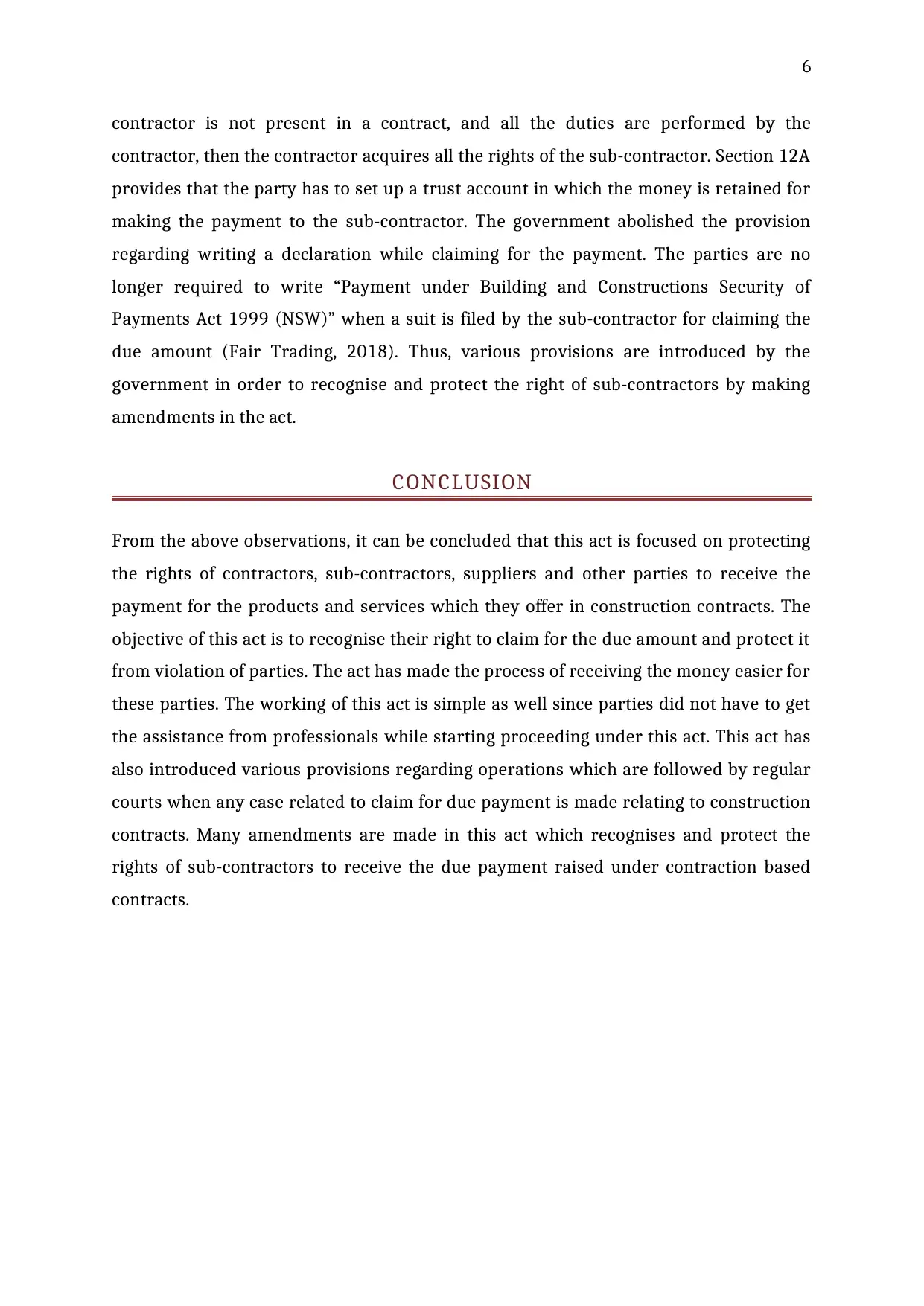
6
contractor is not present in a contract, and all the duties are performed by the
contractor, then the contractor acquires all the rights of the sub-contractor. Section 12A
provides that the party has to set up a trust account in which the money is retained for
making the payment to the sub-contractor. The government abolished the provision
regarding writing a declaration while claiming for the payment. The parties are no
longer required to write “Payment under Building and Constructions Security of
Payments Act 1999 (NSW)” when a suit is filed by the sub-contractor for claiming the
due amount (Fair Trading, 2018). Thus, various provisions are introduced by the
government in order to recognise and protect the right of sub-contractors by making
amendments in the act.
CONCLUSION
From the above observations, it can be concluded that this act is focused on protecting
the rights of contractors, sub-contractors, suppliers and other parties to receive the
payment for the products and services which they offer in construction contracts. The
objective of this act is to recognise their right to claim for the due amount and protect it
from violation of parties. The act has made the process of receiving the money easier for
these parties. The working of this act is simple as well since parties did not have to get
the assistance from professionals while starting proceeding under this act. This act has
also introduced various provisions regarding operations which are followed by regular
courts when any case related to claim for due payment is made relating to construction
contracts. Many amendments are made in this act which recognises and protect the
rights of sub-contractors to receive the due payment raised under contraction based
contracts.
contractor is not present in a contract, and all the duties are performed by the
contractor, then the contractor acquires all the rights of the sub-contractor. Section 12A
provides that the party has to set up a trust account in which the money is retained for
making the payment to the sub-contractor. The government abolished the provision
regarding writing a declaration while claiming for the payment. The parties are no
longer required to write “Payment under Building and Constructions Security of
Payments Act 1999 (NSW)” when a suit is filed by the sub-contractor for claiming the
due amount (Fair Trading, 2018). Thus, various provisions are introduced by the
government in order to recognise and protect the right of sub-contractors by making
amendments in the act.
CONCLUSION
From the above observations, it can be concluded that this act is focused on protecting
the rights of contractors, sub-contractors, suppliers and other parties to receive the
payment for the products and services which they offer in construction contracts. The
objective of this act is to recognise their right to claim for the due amount and protect it
from violation of parties. The act has made the process of receiving the money easier for
these parties. The working of this act is simple as well since parties did not have to get
the assistance from professionals while starting proceeding under this act. This act has
also introduced various provisions regarding operations which are followed by regular
courts when any case related to claim for due payment is made relating to construction
contracts. Many amendments are made in this act which recognises and protect the
rights of sub-contractors to receive the due payment raised under contraction based
contracts.
Paraphrase This Document
Need a fresh take? Get an instant paraphrase of this document with our AI Paraphraser
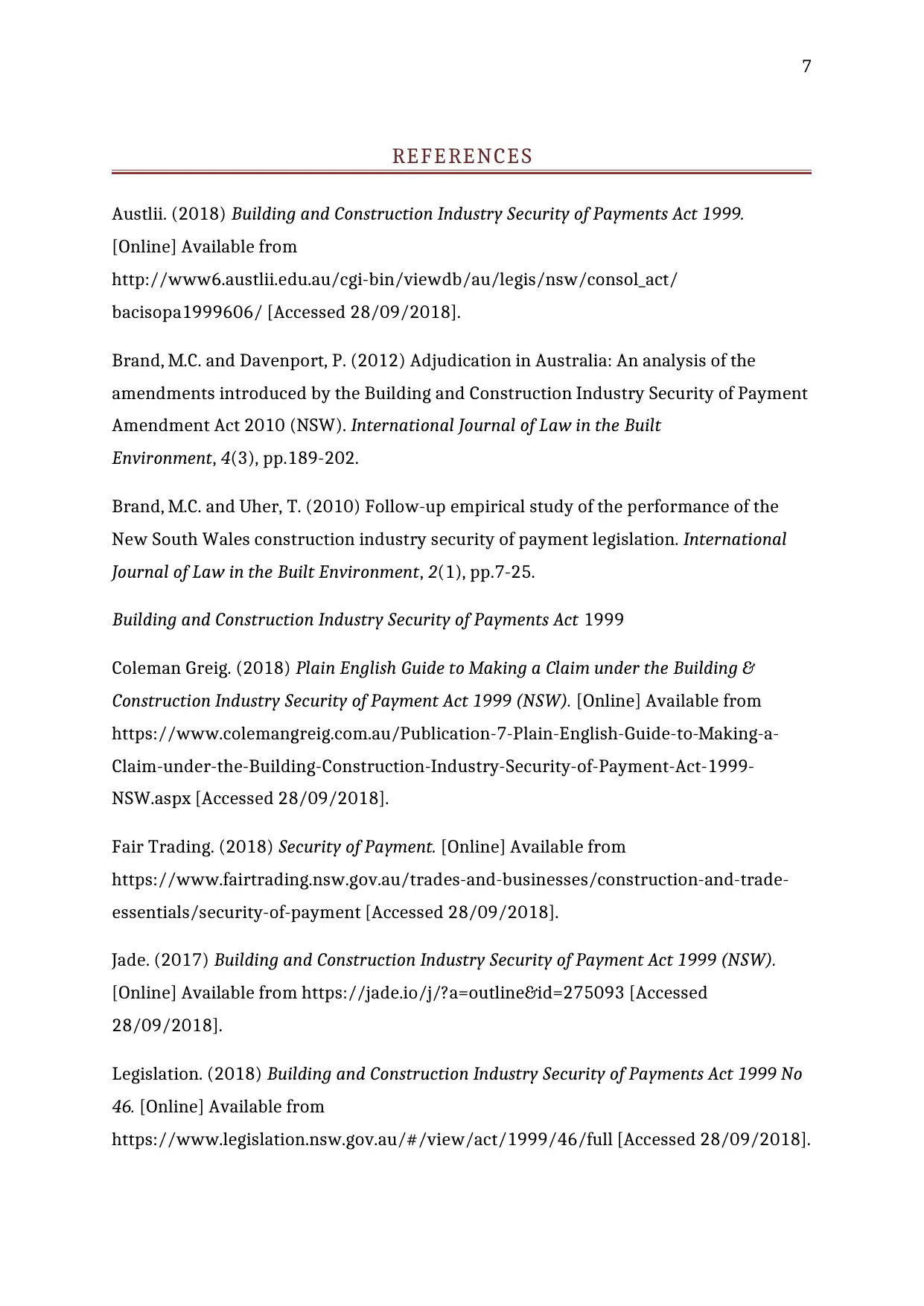
7
REFERENCES
Austlii. (2018) Building and Construction Industry Security of Payments Act 1999.
[Online] Available from
http://www6.austlii.edu.au/cgi-bin/viewdb/au/legis/nsw/consol_act/
bacisopa1999606/ [Accessed 28/09/2018].
Brand, M.C. and Davenport, P. (2012) Adjudication in Australia: An analysis of the
amendments introduced by the Building and Construction Industry Security of Payment
Amendment Act 2010 (NSW). International Journal of Law in the Built
Environment, 4(3), pp.189-202.
Brand, M.C. and Uher, T. (2010) Follow-up empirical study of the performance of the
New South Wales construction industry security of payment legislation. International
Journal of Law in the Built Environment, 2(1), pp.7-25.
Building and Construction Industry Security of Payments Act 1999
Coleman Greig. (2018) Plain English Guide to Making a Claim under the Building &
Construction Industry Security of Payment Act 1999 (NSW). [Online] Available from
https://www.colemangreig.com.au/Publication-7-Plain-English-Guide-to-Making-a-
Claim-under-the-Building-Construction-Industry-Security-of-Payment-Act-1999-
NSW.aspx [Accessed 28/09/2018].
Fair Trading. (2018) Security of Payment. [Online] Available from
https://www.fairtrading.nsw.gov.au/trades-and-businesses/construction-and-trade-
essentials/security-of-payment [Accessed 28/09/2018].
Jade. (2017) Building and Construction Industry Security of Payment Act 1999 (NSW).
[Online] Available from https://jade.io/j/?a=outline&id=275093 [Accessed
28/09/2018].
Legislation. (2018) Building and Construction Industry Security of Payments Act 1999 No
46. [Online] Available from
https://www.legislation.nsw.gov.au/#/view/act/1999/46/full [Accessed 28/09/2018].
REFERENCES
Austlii. (2018) Building and Construction Industry Security of Payments Act 1999.
[Online] Available from
http://www6.austlii.edu.au/cgi-bin/viewdb/au/legis/nsw/consol_act/
bacisopa1999606/ [Accessed 28/09/2018].
Brand, M.C. and Davenport, P. (2012) Adjudication in Australia: An analysis of the
amendments introduced by the Building and Construction Industry Security of Payment
Amendment Act 2010 (NSW). International Journal of Law in the Built
Environment, 4(3), pp.189-202.
Brand, M.C. and Uher, T. (2010) Follow-up empirical study of the performance of the
New South Wales construction industry security of payment legislation. International
Journal of Law in the Built Environment, 2(1), pp.7-25.
Building and Construction Industry Security of Payments Act 1999
Coleman Greig. (2018) Plain English Guide to Making a Claim under the Building &
Construction Industry Security of Payment Act 1999 (NSW). [Online] Available from
https://www.colemangreig.com.au/Publication-7-Plain-English-Guide-to-Making-a-
Claim-under-the-Building-Construction-Industry-Security-of-Payment-Act-1999-
NSW.aspx [Accessed 28/09/2018].
Fair Trading. (2018) Security of Payment. [Online] Available from
https://www.fairtrading.nsw.gov.au/trades-and-businesses/construction-and-trade-
essentials/security-of-payment [Accessed 28/09/2018].
Jade. (2017) Building and Construction Industry Security of Payment Act 1999 (NSW).
[Online] Available from https://jade.io/j/?a=outline&id=275093 [Accessed
28/09/2018].
Legislation. (2018) Building and Construction Industry Security of Payments Act 1999 No
46. [Online] Available from
https://www.legislation.nsw.gov.au/#/view/act/1999/46/full [Accessed 28/09/2018].
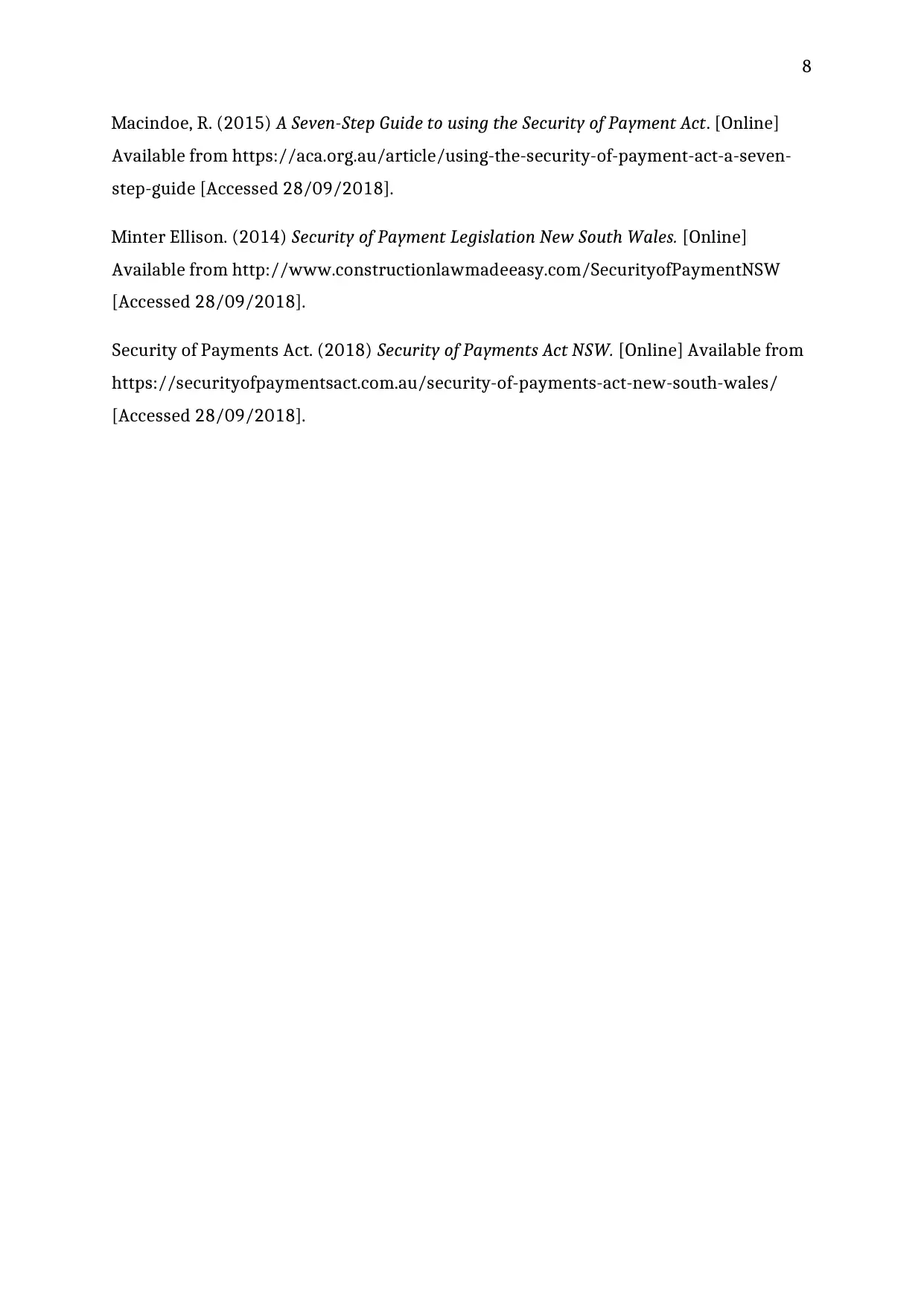
8
Macindoe, R. (2015) A Seven-Step Guide to using the Security of Payment Act. [Online]
Available from https://aca.org.au/article/using-the-security-of-payment-act-a-seven-
step-guide [Accessed 28/09/2018].
Minter Ellison. (2014) Security of Payment Legislation New South Wales. [Online]
Available from http://www.constructionlawmadeeasy.com/SecurityofPaymentNSW
[Accessed 28/09/2018].
Security of Payments Act. (2018) Security of Payments Act NSW. [Online] Available from
https://securityofpaymentsact.com.au/security-of-payments-act-new-south-wales/
[Accessed 28/09/2018].
Macindoe, R. (2015) A Seven-Step Guide to using the Security of Payment Act. [Online]
Available from https://aca.org.au/article/using-the-security-of-payment-act-a-seven-
step-guide [Accessed 28/09/2018].
Minter Ellison. (2014) Security of Payment Legislation New South Wales. [Online]
Available from http://www.constructionlawmadeeasy.com/SecurityofPaymentNSW
[Accessed 28/09/2018].
Security of Payments Act. (2018) Security of Payments Act NSW. [Online] Available from
https://securityofpaymentsact.com.au/security-of-payments-act-new-south-wales/
[Accessed 28/09/2018].
⊘ This is a preview!⊘
Do you want full access?
Subscribe today to unlock all pages.

Trusted by 1+ million students worldwide
1 out of 9
Related Documents
Your All-in-One AI-Powered Toolkit for Academic Success.
+13062052269
info@desklib.com
Available 24*7 on WhatsApp / Email
![[object Object]](/_next/static/media/star-bottom.7253800d.svg)
Unlock your academic potential
Copyright © 2020–2025 A2Z Services. All Rights Reserved. Developed and managed by ZUCOL.




